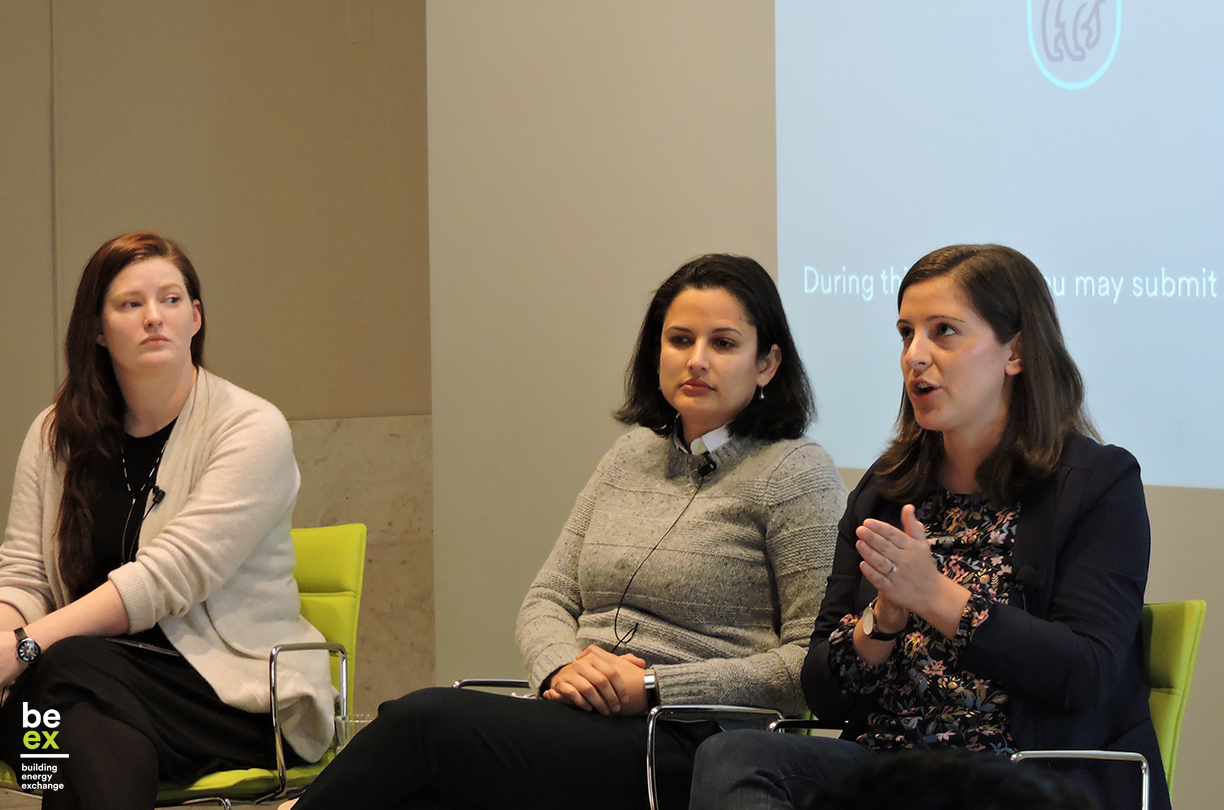By Becky Kalish, Programs Associate, BE-Ex
—
Wednesday morning, January 15, marked the latest event in our ongoing Climate Mobilization Act (CMA) series, a collection of programs and resources dedicated to demystifying the legislative package and connecting our community with relevant solutions. Grades, Codes & Limits is the sixth program in the CMA series and the second event in partnership with the Natural Resources Defense Council, focusing on solutions to the CMA’s various requirements. In particular, this event focused on the new building energy grade labels and carbon limits that will be put into effect October 2020. Donna De Costanzo, Director of the Climate & Clean Energy Program at Natural Resources Defense Council, moderated the event, guiding the conversation and explaining how the new building energy grade labels will affect all parts of the equation. Panelists included John Lee, Deputy Director of Green Buildings and Energy Efficiency at NYC Mayor’s Office of Sustainability; Andrea Mancino, Director of New Construction at Bright Power, Inc.; Kelly Dougherty, Vice President at FS Residential; and Amalia Cuadra, Senior Director of Engineering at EN-POWER Group.
BE-Ex’s Managing Director of Strategy and Programs, Yetsuh Frank, began the presentation with an overview of New York City and State climate policy, emphasizing that global emissions are still going up and a lot of work must occur to tackle the ongoing issue. An increase in emissions comes with an increase in the frequency and ferocity of the climate impacts of global warming; buildings in turn can be seen “more as an opportunity than a barrier” to mitigating the effects of global warming, Mr. Frank noted. An encouraging tone was set as the audience waited to hear more about the effects of posting building energy grades, their relationship to Local Law 97 limits, and how building owners and project teams can ensure they are on a path to compliance with these varied requirements.
Ms. De Costanzo began the discussion by asking Mr. Lee how the components of energy labels, the new stretch code, and Local Law 97 are key to the city’s overall carbon footprint. In beginning the discussion, Mr. Lee articulated how energy grades on buildings can be the largest public engagement effort thus far, mentioning how this effort is a wake up call to take impactful action. Building energy grades have the potential to increase the number of energy efficiency projects, as buildings will be judged and penalized based on emissions each year starting in October. Mr. Lee emphasized the additional necessity to move towards the electrification of all building systems, noting that, if phased properly, this switch should result in both a cost and energy reduction. Ms. Cuadra next made an important point that both the energy consumption and the carbon consumption of a building is going to have an effect on owners because now they are responsible, not only from a “shaming” perspective like the letter grade but also for how this is going to increase their operating expenses. In other words, the better the building grade, the lower the operating expenses of the building. Building grade labels have real and tangible effects both to what consumers see as well as to the building’s financial situation. In agreement, Ms. Dougherty claimed that putting the grade on a building will motivate her clients to take action, which should lead to lower carbon emissions. The next step to take will be engaging all building owners to ensure proactive behavior is universal.
Ms. De Costanzo prompted the panelists to speak about tenant relationships in respect to the new building requirements. Ms. Dougherty began by mentioning the necessity to be creative and really engage tenants to take action—tenant efficiency nights (a chance for tenants to gather and learn about energy efficiency in their building) and energy efficiency apartment guides, to name a few. Additionally important are having “measures that can be easily manipulated by tenants, and constantly ensuring that tenants are engaged”, added Ms. Mancino. There are additionally a number of resources available to aid tenants in the process: the NYC Accelerator, a free outreach program to assist all building types, and both owners and tenants, the new PACE (Property Assessed Clean Energy Financing) lending program, and looking at capital plans. Panelists additionally mentioned the importance of moving to heat pumps, getting buildings off of oil and gas, electrifying buildings, making building envelopes tighter, and being more aggressive in ensuring that tenants are actively engaged.
All in all, there is still a lot of work to be done: while progress has already been made and the measures discussed at the event promise improvement, there is still much more to accomplish, and it will take people from all sides of the equation to ensure dramatic improvements in the efficiency of buildings. As Mr. Lee claimed, the technology to improve buildings has existed for a long time—what we need is more imagination and willingness to go beyond what the codes require. The building energy efficiency labels are built from the data collected through the benchmarking law passed a decade ago, and now bring public transparency to energy use in New York City’s buildings, a necessary first step towards compliance with Local Law 97’s goal of reducing emissions in buildings over 25,000 square feet. Curious to learn more? See here for a full event recording. There will be more upcoming events that are part of the Climate Mobilization Act series—keep an eye out in the BE-Ex calendar and newsletter for announcements on this.


